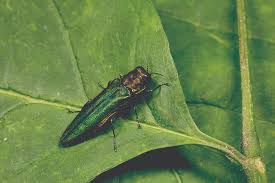
.jpg)
The Emerald Ash Borer (EAB) is a highly destructive, invasive beetle that specifically targets ash trees. Native to Asia, this metallic green insect was first discovered in the U.S. in 2002 and reached Missouri by 2008. Since then, it has devastated millions of ash trees across the Midwest, including right here in the St. Louis area.
What makes EAB so dangerous is the way it attacks from the inside. While adult beetles feed on leaves, it’s the larvae that cause the most damage. They burrow beneath the bark and tunnel through the tree’s vascular system, cutting off the flow of water and nutrients. This silent destruction continues unnoticed until the tree begins to show signs of decline, often too late to reverse the damage.
If not detected and treated early, Emerald Ash Borer infestations typically kill a tree within 3 to 5 years. With ash trees making up a large portion of the urban canopy in St. Louis, this pest poses a serious threat to both residential properties and city landscapes.
Emerald Ash Borer damage often goes unnoticed until it’s advanced, which is why early detection is so important. If you have ash trees on your property, here are the most common signs to watch for:
Emerald Ash Borer doesn’t just affect a single tree, it poses a widespread threat to every ash tree in your area. Once established, this invasive pest spreads quickly, often going undetected until it’s too late.
Adult beetles can fly up to a few miles from the tree where they emerged, allowing them to naturally infest nearby ash trees. However, the most common way EAB spreads long distances is through human activity, especially the movement of infested firewood, logs, or nursery stock. That’s why transporting firewood across counties or states is strongly discouraged and often regulated.
Because ash trees are so common in St. Louis and surrounding areas, a single infestation can lead to widespread tree loss in a matter of years. If even one ash tree on your property is infected, nearby trees, on your neighbor’s property or along city streets, are at risk too.
Stopping the spread starts with early detection, responsible wood handling, and working with certified arborists to monitor and manage the health of ash trees in your landscape.
The Emerald Ash Borer exclusively targets ash trees, which have long been a staple in both natural forests and residential landscapes throughout Missouri and the St. Louis region. Because ash was widely planted along streets, in parks, and in yards due to its fast growth and attractive form, EAB poses a serious threat to a large portion of our urban canopy.
Here are the ash species commonly found in Missouri and St. Louis that are highly susceptible:
The good news is that early intervention can save healthy ash trees from Emerald Ash Borer, but timing is critical. If the infestation has already progressed too far, treatment may no longer be effective, and removal becomes the safest option. That’s why prevention and regular monitoring are so important.
Here’s how Emerald Ash Borer can be managed:
At Ballwin Tree Service, our ISA Certified Arborists have the experience and tools to accurately assess your tree, recommend the best treatment, or safely handle removal when necessary. Don’t wait until it’s too late, contact us today to schedule your tree health assesment and take the first step toward protecting your trees from Emerald Ash Borer.

%20(1)-min.jpg)